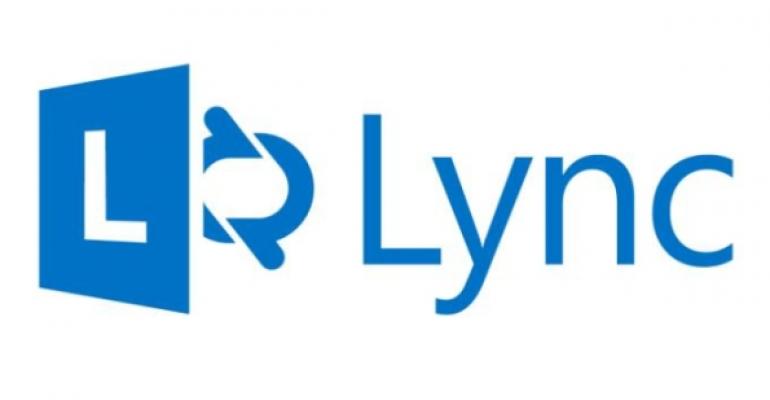Administrators often look to Lync Server cumulative updates to address problems, but little notice is given to Lync client cumulative updates. However, attention should be given to the November 2013 Cumulative Update for Lync 2013 clients, as it includes a lot of features that both administrators and users have been requesting for a long time—features that weren't included in the release to manufacturing (RTM) version of the Lync 2013 client.
Related: Microsoft Lync App Updated for Windows 8.1
Here are some of the key features that the November 2013 Cumulative Update brings to the table:
- Spell checker
- Photos of sender and receiver
- External photos
- Persistent Chat conferencing
- Recording options
- Sign-in Logs option
Spell Checker
Administrators, end users, and other people in organizations, have been clamoring for a spell checker in the Lync client for a long time. Well, the wait is over, as the spell checker provided by the November 2013 Cumulative Update is apparent and working, as Figure 1 shows.

I have mixed feelings about this feature. Although useful, we've grown to expect some words to be misspelled—after all, this is IM and instant messages don't have be perfect. All kidding aside, as the number of organizations using Lync for customer communications has increased, so has the need for those communications to include correctly spelled words.
Photos of Sender and Receiver
In the past, when you wanted to have an IM conversation with someone, you could only see the photo of that person through the contact card. Now you can see the person's photo in the actual IM session while you're chatting, as Figure 2 shows.

Some people might feel that this feature is overkill, but there are situations in which it can be helpful. For example, suppose you're a participant in an IM conference that includes many people. (An IM conference is an IM conversation that involves three or more people.) Most people are picture oriented, so they'll end up looking at the picture first, rather than the name, to keep track of who is saying what.
External Photos
External photos were introduced in Lync 2010 on the client side. Users could incorporate nonstandard company photos into Lync by referencing an external public-facing URL to a social media website such as Facebook. Administrators then discovered that they could remove this option through the Lync Server Management Shell. Many organizations removed this option to restrict users from pointing to pictures that were considered inappropriate for the workplace.
In the initial release of the Lync 2013 client, the external photo option wasn't available. The November 2013 Cumulative Update for Lync 2013 clients has brought this feature back, with one caveat. It has to be enabled with the Lync Server Management Shell's New-CsClientPolicyEntry cmdlet. Specifically, you need to run the command:
New-CsClientPolicyEntry -Name EnablePresencePhotoOptions ` -Value true
You can find more information about external photos in the Set My Picture options web page.
Persistent Chat Conferencing
If you don't use Persistent Chat very often, maybe the Persistent Chat conferencing feature will change that. With Persistent Chat conferencing, you can move directly from a chat room to a conference call. I'm ecstatic about this particular feature. I can see myself working on an escalated support ticket, going back and forth with team members, then deciding to have a conference call to discuss the matter in more depth.
Here's how Persistent Chat conferencing works. Within the chat window, you simply click the phone icon shown in Figure 3 to initiate a conference call.

After clicking the phone icon, a dialog box (shown in Figure 4) will appear, letting you know a few details about the meeting. It lets you know that meeting participants can invite other people to the meeting. The dialog box also lets you know that any meeting content (e.g., whiteboards, polls, Microsoft PowerPoint slides) displayed in the meeting won't be available in the chat room.

After you click OK in the dialog box, a meeting URL will be sent to the other chat room participants, as Figure 5 shows.

To join the meeting, all they need to do is click the URL. This meeting URL will become persistent in the IM session in the chat room. If another call is initiated by the same user, a different URL will be provided for that particular meeting.
Recording Options
In the Lync 2013 client, users have the ability to record sessions—audio sessions, video sessions, desktop sharing, and basically anything else that happens in a conference. Thanks to the November 2013 Cumulative Update, users can now record sessions at different resolutions, as Figure 6 shows. Note that administrators can control which users have the ability to record sessions in the conferencing section of the Lync Control Panel.

Sign-in Logs Option
Gone are the days of having to find the tracing folder and opening up a Session Initiation Protocol (SIP) packet tracing tool (aka a "snooper") to troubleshoot why a user can't log on. After you install the November 2013 Cumulative Update, users are still going to occasionally have problems logging on to Lync 2013, but getting to the needed information to begin troubleshooting the problem has gotten a lot easier. A new Sign-in Logs option in the Lync 2013 client, shown in Figure 7, lets users view and copy logon information, which they can then send to the Help desk.

New Updates Are Worth the Wait
IT administrators, especially those who work with Microsoft products, tend to hold off installing cumulative updates for clients in their environment for as long as possible. However, the November 2013 Cumulative Update for Lync 2013 clients should be the exception. You should install it as soon as possible. There are so many new and improved features in this update that it's hard to imagine another one living up to its reputation.





